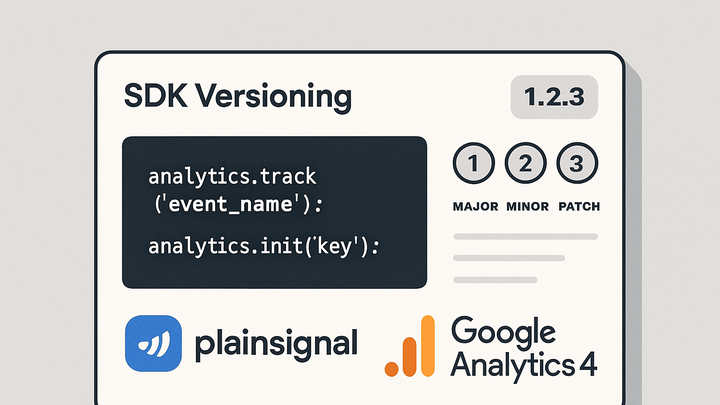Published on 2025-06-22T09:27:01Z
What is SDK Version? Examples in Analytics
In analytics, an SDK version refers to the specific release identifier for a software development kit (SDK) provided by an analytics platform such as plainSignal or Google Analytics 4 (GA4). Each version follows a versioning scheme, often semantic versioning, to communicate changes like feature additions, bug fixes, or breaking changes. By referencing an SDK version, developers can ensure consistent behavior across their applications and track updates in a controlled manner. Monitoring SDK versions is crucial for maintaining compatibility with dependencies, enabling new analytics features, and preserving data integrity. Failing to update or comply with version requirements can lead to tracking errors, performance issues, or security vulnerabilities. This glossary article explores the practical implications of SDK versioning in analytics, demonstrates how to check and update versions, and shares best practices for managing analytics SDK releases. We’ll illustrate with code examples from plainSignal (a cookie-free analytics tool) and GA4 (Google Analytics 4).
Sdk version
An SDK Version identifies a specific release of an analytics SDK, guiding updates, compatibility, and feature management.
Introduction to SDK Versions
This section defines what an SDK version is and its role in analytics integrations.
-
Sdk version definition
An SDK version is a unique identifier (often formatted as
MAJOR.MINOR.PATCH) that indicates the release state of a software development kit used for analytics data collection and instrumentation.
Importance of SDK Versions in Analytics
This section explores why tracking and managing SDK versions is critical for reliable analytics data.
-
Compatibility and stability
Ensures that the integrated SDK works seamlessly with the application and third-party dependencies. Upgrading versions without testing can introduce breaking changes and unexpected behaviors.
-
Access to new features
Each new SDK version may include enhancements, improved APIs, or performance optimizations. Staying current unlocks advanced analytics capabilities and refined tracking methods.
-
Security and compliance
SDK updates often address security vulnerabilities or compliance regulations. Running outdated versions can expose data to risks or violate privacy standards.
How to Check SDK Versions
This section covers methods to discover which SDK version is currently in use for both plainSignal and GA4 integrations.
-
Checking PlainSignal sdk version
- Inspect the script URL loaded in your HTML. For example:
<link rel="preconnect" href="//eu.plainsignal.com/" crossorigin /> <script defer data-do="yourwebsitedomain.com" data-id="0GQV1xmtzQQ" data-api="//eu.plainsignal.com" src="//cdn.plainsignal.com/plainsignal-min.js"></script>- Look for version identifiers in the URL (e.g.,
plainsignal-min.js?v=1.2.3) or check the network tab to see query parameters indicating the version. - If the version isn’t visible, open the file in the Sources panel and search for version metadata or comments at the top of the JavaScript file.
-
Checking GA4 sdk version
- Review the gtag.js URL loaded:
<script async src="https://www.googletagmanager.com/gtag/js?id=GA_MEASUREMENT_ID"></script>- In DevTools Network tab, locate the
gtag/jsrequest and inspect query parameters such asv=1.0. - Open the downloaded file in the Sources panel and search for a version string or comment at the header.
Managing and Updating SDK Versions
This section outlines best practices for upgrading and specifying SDK versions to maintain analytics integrity.
-
Use semantic versioning
Adopt a versioning scheme in the format
MAJOR.MINOR.PATCH. Breaking changes increment MAJOR, backward-compatible features bump MINOR, and bug fixes update PATCH. This clarity helps teams make informed upgrade decisions. -
Pin and lock versions
Specify exact SDK versions in your script URLs or package managers (e.g., npm dependency
"PlainSignal": "1.2.3"). Avoid relying onlatesttags to prevent unexpected changes. -
Testing and rollback strategies
Validate new SDK releases in staging environments and monitor key metrics after deployment. Have a rollback plan ready to revert to the previous version if issues arise.
SDK Versioning in Practice: Example Upgrade
An example workflow for upgrading the plainSignal SDK from one version to another with verification steps.
-
Review the changelog
Before upgrading, read the SDK provider’s changelog to identify potential breaking changes, new features, and bug fixes.
-
Update script reference
Modify the
srcattribute of the script tag to point to the new version. See examples below:-
Old version
<script defer src="//cdn.plainsignal.com/plainsignal-min.js?v=1.2.3"></script> -
New version
<script defer src="//cdn.plainsignal.com/plainsignal-min.js?v=1.3.0"></script>
-
-
Validate data collection
After deployment, verify that analytics events are being recorded correctly by using debug tools (e.g., plainSignal’s real-time console or GA4 DebugView). Monitor for errors in the console.
